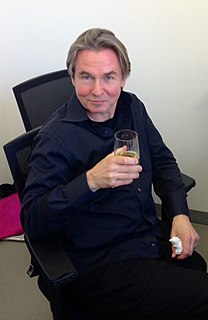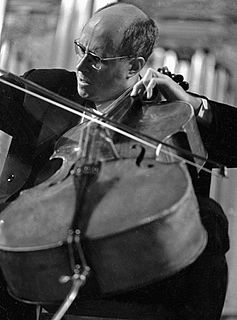Related Research Articles

Esa-Pekka Salonen is a Finnish orchestral conductor and composer. He is principal conductor and artistic advisor of the Philharmonia Orchestra in London, conductor laureate of the Los Angeles Philharmonic, and music director-designate of the San Francisco Symphony.
The Grammy Award forBest Instrumental Soloist(s) Performance was awarded from 1959 to 2011. From 1967 to 1971, and in 1987, the award was combined with the award for Best Instrumental Soloist Performance and awarded as the Grammy Award for Best Classical Performance – Instrumental Soloist or Soloists.

Magnus Gustaf Adolf Lindberg is a Finnish composer and pianist. He was the New York Philharmonic's composer-in-residence from 2009 to 2012 and has been the London Philharmonic Orchestra's composer-in-residence since the beginning of the 2014–15 season.

Edward Elgar's Cello Concerto in E minor, Op. 85, his last notable work, is a cornerstone of the solo cello repertoire. Elgar composed it in the aftermath of the First World War, when his music had already gone out of fashion with the concert-going public. In contrast with Elgar's earlier Violin Concerto, which is lyrical and passionate, the Cello Concerto is for the most part contemplative and elegiac.
The Cello Concerto in B minor, Op. 104, B. 191, is the last solo concerto by Antonín Dvořák. It was written in 1894 for his friend, the cellist Hanuš Wihan, but was premiered by the English cellist Leo Stern.
Béla Bartók's Piano Concerto No. 2 in G major, Sz. 95, BB 101 (1930–31), the second of his three piano concerti, is notorious for being one of the most difficult pieces in the repertoire.
Roland Peter Pöntinen is a Swedish pianist and composer.
Andrew Shulman is an English virtuoso cellist, conductor and composer. He is currently the principal cellist of the Los Angeles Chamber Orchestra. as well as being Professor of Cello at the University of Southern California's Thornton School of Music in Los Angeles, California.
James Matheson is an American composer. His works have been commissioned and performed by the Albany Symphony Orchestra, Chicago Symphony Orchestra, Los Angeles Philharmonic, New York Philharmonic, Borromeo String Quartet, Carnegie Hall and the St. Lawrence String Quartet. In December 2011, he received the Charles Ives Living from the American Academy of Arts and Letters, an award providing him with $100,000 for two years (2012-2014). Previously, he received the Academy’s Goddard Lieberson Fellowship in 2008 and Hinrichsen Award in 2002. He has also received awards from the Civitella Ranieri, Bogliasco and Sage Foundations, ASCAP, and the Robbins Prize. He was executive director of the MATA Festival of New Music in New York from 2005-2007 and has been a fellow at the Aspen Music Festival. Since September 2009, he has been the director of the Los Angeles Philharmonic’s Composer Fellowship Program.

Tout un monde lointain... is a concertante work for cello and orchestra composed by Henri Dutilleux between 1967 and 1970 for Mstislav Rostropovich. It is considered one of the most important 20th-century additions to the cello repertoire and several major cellists have recorded it. Despite the fact that the score does not state that it is a cello concerto, Tout un monde lointain... has always been considered as such.
The Violin Concerto is the only violin concerto by the Finnish conductor and composer Esa-Pekka Salonen. It was finished in 2009 and has become one of Salonen's major works.
The Piano Concerto is a concerto for solo piano and orchestra in three movements by the Finnish composer Esa-Pekka Salonen. The work was jointly commissioned by the New York Philharmonic, the BBC, the NDR Symphony Orchestra, and Radio France. It was premiered February 1, 2007 in Avery Fisher Hall, New York City, with Salonen conducting the pianist Yefim Bronfman and the New York Philharmonic. Salonen dedicated the piece to Yefim Bronfman.
Nyx is a symphonic poem by the Finnish composer Esa-Pekka Salonen. The work was jointly commissioned by Radio France, the Barbican Centre, the Atlanta Symphony Orchestra, Carnegie Hall, and the Finnish Broadcasting Company. It was premiered February 19, 2011 in the Théâtre du Châtelet, Paris, with Salonen conducting the Orchestre Philharmonique de Radio France. The piece is titled after the Goddess Nyx from Greek mythology.
L.A. Variations is an orchestral composition by the Finnish composer Esa-Pekka Salonen. The work was commissioned by the Los Angeles Philharmonic, of which Salonen was then music director. It was first performed at the Dorothy Chandler Pavilion in Los Angeles, January 16, 1997, with Salonen conducting the Los Angeles Philharmonic. The piece is dedicated to the orchestra, about which Salonen remarked, "I wrote LA Variations specifically for the players of the Los Angeles Philharmonic. I'm very proud of the virtuosity and power of my orchestra."
The Concerto for Two Flutes and Orchestra is a composition for two flutes and orchestra by the American composer Steven Stucky. The work was commissioned by the Los Angeles Philharmonic, for which Stucky was formerly composer-in-residence and then New Music Adviser. The piece was composed from October through December 1994 and was given its world premiere in Los Angeles by the Los Angeles Philharmonic under the conductor Esa-Pekka Salonen on February 23, 1995.
The Cello Concerto No. 2 is the second cello concerto by the Finnish composer Magnus Lindberg. It was commissioned by the Los Angeles Philharmonic in June 2013 to fill the planned premiere date of Oliver Knussen's then delayed Cello Concerto. The work was first performed in the Walt Disney Concert Hall, Los Angeles, on October 18, 2013 by the Finnish cellist Anssi Karttunen and the Los Angeles Philharmonic under the direction of Esa-Pekka Salonen.
The Cello Concerto No. 1 is a composition for solo cello and orchestra by the Finnish composer Magnus Lindberg. It was first performed in the Cité de la Musique, Paris on May 6, 1999 by the cellist Anssi Karttunen and the Orchestre de Paris under the direction of Esa-Pekka Salonen.
Fresco is an orchestral composition by the Finnish composer Magnus Lindberg. The work was commissioned by the Los Angeles Philharmonic. Its world premiere was given in Los Angeles on March 12, 1998 by the Los Angeles Philharmonic under the direction of Esa-Pekka Salonen, to whom the piece is dedicated.
Parada is an orchestral composition by the Finnish composer Magnus Lindberg. The piece was composed for the music festival Related Rocks which celebrates the works of Lindberg and related composers. Its world premiere was given at The Anvil, Basingstoke on February 6, 2002 by the Philharmonia Orchestra under the direction of Esa-Pekka Salonen, to whom the work is dedicated.
Karawane is a composition for chorus and orchestra by the Finnish composer Esa-Pekka Salonen. The work was jointly commissioned by the Tonhalle Orchester Zürich, the Swedish Radio Symphony Orchestra, the New York Philharmonic with support from the philanthropist Marie-Josée Kravis, the Bamberg Symphony, and the Finnish Radio Symphony Orchestra. It was first performed by the Tonhalle Orchester Zürich and the Zürcher Sing-Akademie conducted by Lionel Bringuier in the Tonhalle, Zürich, on September 10, 2014. The piece is set to the eponymous poem by the German author and Dadaist Hugo Ball.
References
- 1 2 3 4 Salonen, Esa-Pekka (2016). "Cello Concerto". G. Schirmer Inc. Retrieved April 17, 2017.
- ↑ Mermelstein, David (March 10, 2017). "Esa-Pekka Salonen and Yo-Yo Ma in Chicago: The two paired with the Chicago Symphony Orchestra in the world premiere of Mr. Salonen's Cello Concerto". The Wall Street Journal . Retrieved April 17, 2017.
- ↑ Ross, Alex (March 20, 2017). "A Complex Concerto for Yo-Yo Ma: The cellist joins Alan Gilbert and the New York Philharmonic to play a new work by Esa-Pekka Salonen". The New Yorker . Retrieved April 17, 2017.
- ↑ Woolfe, Zachary (March 13, 2017). "Write Me a Concerto: Yo-Yo Ma and Esa-Pekka Salonen on Their New Work". The New York Times . Retrieved April 17, 2017.
- ↑ Rabillon, Katharina (24 August 2017). "Esa Pekka Salonen's devilishly difficult and cosmic Cello Concerto". Euronews . Retrieved 28 February 2019.
- ↑ von Rhein, John (March 10, 2017). "Yo-Yo Ma reaches for stars in world premiere of Salonen's Cello Concerto at CSO". Chicago Tribune . Retrieved April 17, 2017.
- ↑ Johnson, Lawrence A. (March 10, 2017). "Ma, CSO give Salonen's Cello Concerto a rousing premiere". Chicago Classical Review. Retrieved April 17, 2017.
- ↑ Tommasini, Anthony (March 16, 2017). "New Concerto, New Leader: A Big Day at the New York Philharmonic". The New York Times . Retrieved April 17, 2017.
- ↑ Wright, David (March 16, 2017). "Salonen's new Cello Concerto a mixed bag of cool from Ma, Philharmonic". New York Classical Review. Retrieved April 17, 2017.